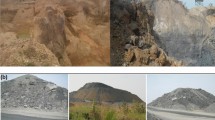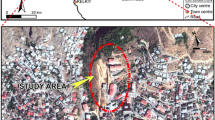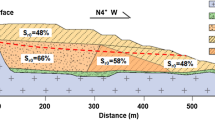Abstract
This paper presents results on the stability of slopes of the mine tailing dumps at Enyigba, Southeastern Nigeria. The geotechnical parameters of the slopes were investigated, and stability analysis was carried out with GeoStudio® 2012 developed by Geoslope International Limited. The slope materials were composed of gravel (1.42–30.13%), sand (15.94–33.34%), silt (9.75–26.87%) and clay (32.1–56.25%). The materials have LL, PL and PI ranging from 24 to 49%, 24 to 35% and 9 to 26% respectively, signifying low to medium plastic materials. These results agree with the soil low permeability (10−4 – 10−8 cm/s) recorded. The MDD and OMC of the material ranged from 1.86 to 2.22 g/cm3 and 13.45 to 17.05%, while cohesion and internal friction angle were recorded to be 13–34 kN/m2 and 8–37° respectively; implying moderately durable materials capable of slip and shear failures. XRD confirmed the presence of swelling mineral (illite) in soil material, hinting at clay plasticity on absorption of moisture, which is one of the factors influencing all forms of mass wasting. The slopes’ computed factor of safety ranged from 0.8 to 1.33, suggesting critical to poor slope stability when exposed to landslide triggering agents. Hence, slope stabilization is required on the mine tailing dumps at Enyigba to prevent major landslide occurrence.















Similar content being viewed by others
References
Agumanu AE (1989) The Abakaliki and Ebonyi formations: sub-divisions of the AlbianAsu River group in the southern Benue trough, Nigeria. J Afr Earth Sci 9(1):195–207
Alemdag S, Akgun A, Kaya A, Gokceglu C (2014) A large and rapid planar failure: causes, mechanism, and consequences (Mordut, Gumushane, Turkey). Arab J Geosci 7(3):1205–1221
American Society for Testing and Materials (1994). Annual Book of ASTM standard. Standard test methods for laboratory determination of particle size analysis of soil, D 421, 04008, ASTM International, West Conshohocken Philadephia.
American Society for Testing and materials (2007). Standard test method for particle size analysis of soils (hydrometer analysis of percent passing 2 μm ASTM sieve opening which is predominantly clay fraction) D 422,ASTM International, West Conshohocken Philadephia.
Bahadur RP, Sudeep M (2013) Overburden dump slope stability: a case study at coal mine. B Tech thesis. National Institute of Technology, Rourkela, Odisha-769008
Baynes FJ (2008) Anticipating problem soils on linear projects. In: Conference proceedings on problem soils in South Africa, 3–4 November 2008, pp 9–21
Behera PK, Sarkar K, Singh AK, Verma AK, Singh TN (2016) Dump slope stability analysis- a case study. J Geol Soc India 88:725–735
Benkhelil J (1986) Structure et evolutiongeodynamique due basin intercontinental de la Benoue (Nigeria). Bull Centres Rech Explor Prod Elf-Aquitaine 12(1):29–128
Blench PO (2004) Regional stratigraphy of Abakaliki, southeastern Nigeria. Corral, Nigeria, pp 14–50
Blight GE, Amponash DF (2004) Towards the 1000-year erosion-free tailings dam slope – a study in South Africa. In: Ground and water bioengineering for erosion control and slope stabilization. Science, Enfiled, pp 365–376
Blyth FGH, De Feritas MH (1984) A geology for engineers. Arnold intern students, 7th edn. Arnold, London, p 325
Bradfield L, Simmons J, Fityus S (2013) Issues related to stability design of very high spoil dumps. Paper presented at the 13th Coal Operators’ Conference, University of Wollongong, pp 376–386
Cheng YM, Lau CK (2014) Slope stability analysis and stabilization, 2nd edn. Taylor & Francis, New York, pp 17–97
Cratchly CR, Jones GP (1965) An interpretation of the geology and gravity anomalies of the Benue Valley, Nigeria. Overseas Geol Surv Geophys Pap 1:1–26
Crosta G, Frattini P (2008) Rainfall-induced landslides and debris flows. Hydrocarb Process 22(4):473–477
Dai FC, Lee CF, Ngai YY (2002) Landslide risk assessment and management: an overview. Eng Geol 64(1):65–87
Das, G. (2011). Analysis of Slope Stability for waste Dumps in a Mine. Btech. thesis, Department of Mining Engineering, National Institute of Technology Rourkela-769008
Ezeh HN, Anike OL (2009) The preliminary assessment of the pollution status of streams and artificial lakes created by mining in the mining district of Enyigba, southeastern Nigeria, and their consequences. Glob J Environ Sci 8(1):41–48
Farrington JL (1952) A preliminary description of the Nigerian lead-zinc field. Econ Geol 47(6):583–608
Fauziah A, Yahaya AS, Farooqi MA (2006) Characterization and geotechnical properties of Penang residual soils with emphasis on landslides. Am J Environ Sci 2(4):121–128. https://doi.org/10.3844/ajessp.2006.121.128
Gao Y, Yin Y, Li B, Wang W, Zhang N, Yang C, Zuo X (2017) Investigation and dynamic analysis of the long runout catastrophic landslide at the Shenzhen landfill on December 20, 2015, in Guangdong, China. Environ Earth Sci 76:13
Glade T (2002) Landslide occurrence as a response to land use change—a review of evidence from New Zealand. Catena 51(3–4):294–314
Gonghui W, Suemine A, Schulz WH (2010) Shear-rate-dependent strength control on the dynamics of rainfall-triggered landslides, Tokushima prefecture, Japan. Earth Surf Process Landf 35(4):407–416. https://doi.org/10.1002/esp.1937
Griffiths D, Marquez R (2007) Three-dimensional slope stability analysis by elasto-plastic finite elements. Géotechnique 57(6):537–546
Gupta AK, Paul B (2016) Augmenting the stability of OB dump by using fly ash: a geo technical approach to sustainably manage OB dump at Jharia coal field, India. Curr World Environ 11(1)
Hong JC, Jong KM, Il SJ (2012) A study of decreasing behavior of strength and elastic parameters due to water infiltration in rock cores. J Korean Geotech Soc 28(1):69–83
Igwe O (2014) The compressibility and shear characteristics of soils associated with landslides in geologically different localities - case examples from Nigeria. Arab J Geosci. https://doi.org/10.1007/s12517-014-1616-3
Igwe O (2015a) The geotechnical characteristics of landslides on the sedimentary and metamorphic terrains of south-East Nigeria, West Africa. Geoenviron Disasters. https://doi.org/10.1186/s40677-014-0008-z
Igwe O (2015b) Stability analysis and simulated hydrologic response of some vulnerable slopes in Nigeria: implications for rainfall-induced landslides. IOSR J Appl Geol Geophys (IOSR-JAGG) 3(3):48–56. https://doi.org/10.9790/0990-03314856
Igwe O, Fukuoka H (2014) The effect of water-saturation on the stability of problematic slopes at the Iva Valley area, Southeast Nigeria. Arab J Geosci. https://doi.org/10.1007/s12517-014-1398-7
Igwe O, Adepehin EJ, Iwuanyanwu C (2012a) Environmental effects of the mining of lead-zinc minerals in Enyingba and its suburbs, southern Benue trough, Nigeria. Nigeria J Educ Health Technol Res 3(2):31–43
Igwe O, Fukuoka H, Sassa K (2012b) The effect of relative density and confining stress on shear properties of sands with varying grading. Geotech Geol Eng 30:1207–1229
Igwe O, Mode W, Nnebedum O, Okonkwo I, Oha I (2013) The analysis of rainfallinduced slope failures at Iva Valley area of Enugu state, Nigeria. Environ Earth Sci. https://doi.org/10.1007/s12665-013-2647-x
Isik Y, Keskin Y (2008) GIS based statistical and physical approaches to landslide susceptibility mapping (Sebinkarahisar, Turkey). Bull Eng Geol Environ 68:459–471
Jadda M, Shafri HZ, Mansor S, Sharifikia M (2009) Landslide susceptibility evaluation and factor effect analysis using probabilistic–frequency ratio model. Eur J Sci Res 33:654–668
Kainthola A, Verma D, Gupte SS, Singh TN (2011) A coal mine dump stability analysis—a case study. Int J Geomaterial 1:1–13
Kalatehjari R, Ali N, Kholghifard M, Hajihassari M (2014) The effects of method of generating circular slip surfaces on determining the critical slip surface by particle swarm optimization. Arab J Geosci 7(4):1529–1539
Kettler, T.A., Doran, J.W. & Gilbert, T.L. (2001). Simplified method for soil particle-size determination to accompany soil-quality analyses; Soil Sci. Soc. Am. J. 65 849–852
King LC (1950) Outline land disruption of Gwanduanaland. Geol Mag V 87:353–359
Kitutu MG, Muwanga A, Poesen J, Deckers JA (2009) Influence of soil properties on landslide occurrence in Bududa district, eastern Uganda. Afr J Agric Res 4(7):611–620
Knapen A, Kitutu MG, Poesen J, Breugelmans W, Deckers J, Muwanga A (2006) Landslides in a densely populated county at the footsteps of mount Elgon (Uganda): characteristics and causal factors. Geomorphology 73:149–165
Kogbe CA (1989) The cretaceous and paleogene sediments of southern Nigeria. In: Kogbe CA (ed) Geology of Nigeria. Rock View, Jos, pp 325–334
Kumar, B.P.A. (2013). Dump slope stability analysis. Btech. thesis. National Institute of Technology Rourkela. pp 1-51
Ma K, Tang CA, Li LC, Ranjith PG, Cai M, Xu NW (2013) 3D modeling of stratified and irregularly jointed rock slope and its progressive failure. Arab J Geosci 6(6):2147–2163
Maduka RI, Igwe O, Ayogu NO, Ayogu CN, Nwachukwu M (2016) Geotechnical assessment of road failure and slope monitoring along Nsukka-Adoru-Idah highway, southeastern Nigeria. Environ Monit Assess. https://doi.org/10.1007/s10661-016-5699-z
Msilimba GG, Holmes PJ (2005) A landslide hazard assessment and vulnerability appraisal procedure: Vunguvungu/Banga catchment, northern Malawi. Nat Hazards 34(2):199–216. https://doi.org/10.1007/s11069-004-1513-2
Mugagga F, Kakembo V, Buyinza M (2011) A characterisation of the physical properties of soil and the implications for landslide occurrence on the slopes of mount Elgon, eastern Uganda. Nat Hazards. https://doi.org/10.1007/s11069-011-9896-3
Murat RC (1972) Stratigraphy and paleogragraphy of the cretaceous and lower tertiary in southern Nigeria. In: African geology Dessauvagie. Ibadan Univ. Press, Ibadan, pp 251–276
Nwachukwu SO (1972) The tectonic evolution of the southern portion of the Benue trough, Nigeria. Geol Mag 109:411–419
Nweke OM (2015) Evaluating the suitability of clays from Abakaliki area, southeastern Nigeria for oil industrial application using geotechnical and rheological properties. Sci Innov 3(2):22–31. https://doi.org/10.11648/j.si.20150302.11
Obiora SC, Charan SN (2011) Geochemistry of regionally metamorphosed sedimentary rocks from the lower Benue rift: implications for provenance and tectonic setting of the Benue rift sedimentary suite. S Afr J Geol 114:25–40
Ohlmacher GC (2000) The relationship between geology and landslide hazards at Atchison, Kansas and vicinity. Curr Res Earth Sci 244(3):1–16
Onda Y, Tsujimura M, Tabuchi H (2004) The role of subsurface water flow paths on hillslope hydrological processes, landslide and landform development in steep mountains of Japan. Hyd Pro J 18(4):637–650
Orajaka S (1965) The geology of Enyigba, Ameri and Amekal lead-zinc lodes Abakaliki, South-Eastern Nigeria: a reconnaissance. J Min Geol 2:65–69
Poulsen B, Khanal M, Rao AM, Adhikary D (2014) Mine overburden dump failure: a case study. Geotech Geol Eng 32:297–309. https://doi.org/10.1007/s10706-013-9714-7
Rahardjo H, Lee T, Leong E, Rezaur R (2005) Response of residual soil slope to rainfall. Can Geotech J 42(2):340–351
Sarkar K, Singh TN, Verma AK (2012) A numerical simulation of landslide-prone slope in Himalayan region—a case study. Arab J Geosci 5(1):73–81
Seedman R (1986) The behavior of clay shales in water. Can Geotech J 23(1):18–22
Singh TN, Pradhan SP, Vishal V (2013) Stability of slopes in a fire-prone mine in Jharia coalfield, India. Arab J Geosci 6(2):419–427
Sowers GB, Sower GE (1970) Introductory soil mechanics and foundations. Macmillan Book Publishing Company, London, p 337
Todd, K.D. (1980). Groundwater hydrology. Wiley, New York, p535
Tuncer OD, Lohnes CG (1977) Specific gravity of soils. J Geol 75:432–534
Ukpong EE, Olade MA (1979) Geochemical surveys for lead-zinc mineralization, southern Benue trough Nigeria. Inst Min and Metal (B) 88:B81–B92
Verma D, Kainthola A, Gupte SS, Singh TN (2013) A finite element approach of stability analysis of internal dump slope in WardhaValley coal field, India, Maharashtra. Am J Miner Metall 1(1):1–6
Wati SE, Hastuti T, Wijojo S, Pinem F (2010) Landslide susceptibility mapping with heuristic approach in mountainous area. A case study in Tawangmangu sub district, central java, Indonesia. Int Arch Photo RS Spat Inf Sci 38(8):248–253
Yalcin A (2007) The effects of clay on landslides: a case study. Appl Clay Sci 38:78–85
Yang H, Adler R, Huffman G (2007) Use of satellite remote sensing in the mapping of global landslide susceptibility. Nat Hazards 43(2):245–256. https://doi.org/10.1007/s11069-006-9104-z
Acknowledgments
The authors sincerely acknowledge the lecturers of Geology department, University of Nigeria, Nsukka; particularly Dr. Ifeanyi Oha and my senior colleagues- Raphael Maduka, Kelvin Una and Uche Chukwura who have contributed wisely to the success of this research work. Special thanks also go to my father, Rev. Chukwu and my entire family for their financial support. Thank you.
Author information
Authors and Affiliations
Corresponding author
Rights and permissions
About this article
Cite this article
Igwe, O., Chukwu, C. Slope stability analysis of mine waste dumps at a mine site in Southeastern Nigeria. Bull Eng Geol Environ 78, 2503–2517 (2019). https://doi.org/10.1007/s10064-018-1304-8
Received:
Accepted:
Published:
Issue Date:
DOI: https://doi.org/10.1007/s10064-018-1304-8




